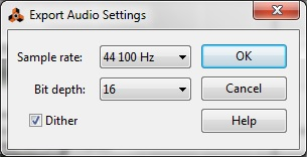|
|
The exported audio file will also contain tempo data as described in “About Tempo data in exported audio files”.
See “Bounce Clip(s) to New Sample(s)” in the “Audio Editing in the Sequencer” chapter for more details.
See “Bounce Clip(s) to New Recording(s)” in the “Audio Editing in the Sequencer” chapter for more details.
See “Bounce Clip to REX Loop” in the “Audio Editing in the Sequencer” chapter for more details.





